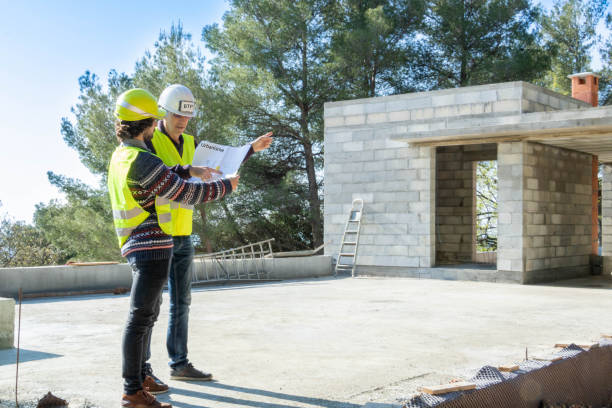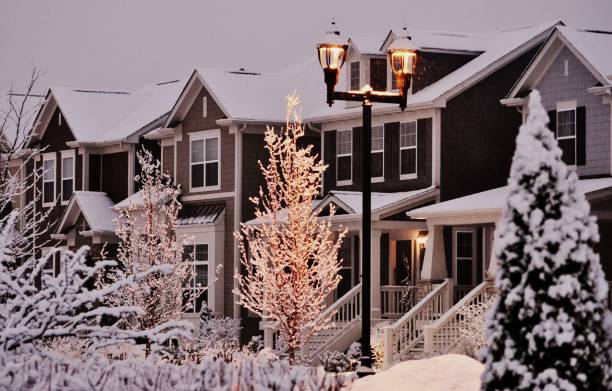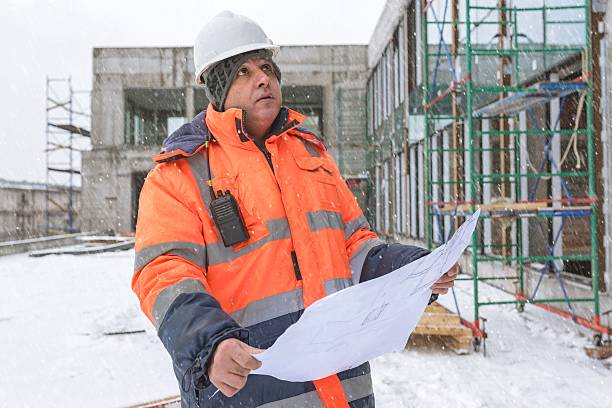Building a home is a significant milestone, often requiring careful planning and decision-making. One crucial factor influencing the construction process is the time of year. While spring and summer are typically popular choices for construction, winter offers unique advantages and challenges worth considering. This article delves into the pros and cons of building a home in winter and provides actionable strategies to navigate potential hurdles, ensuring a successful project.
The Pros of Home Construction in Winter
- Availability of Contractors
Winter is generally considered the off-season for construction, meaning contractors are often more available. Unlike the busier spring and summer months, when schedules are packed, winter allows you to book skilled professionals more easily. This availability can translate to faster project start times and greater attention to your build.
Additionally, reduced contractor workload often means teams can dedicate more time to understanding your vision. This results in better communication, fewer misunderstandings, and a smoother execution of your project plans.
- Cost Savings
Due to reduced demand during winter, construction materials and labour costs are often lower. Suppliers may offer discounts on materials, and contractors might provide more competitive rates. These cost savings can significantly impact your overall budget, enabling you to allocate resources to other aspects of the project.
Furthermore, some financing options may also be more favourable during winter, as lenders often compete to attract clients during slower periods. This can result in lower interest rates or more flexible payment terms for construction loans.
- Efficient Project Management
Contractors and project managers can devote more time and energy to your build with fewer projects. This focused attention can lead to better coordination, fewer mistakes, and a streamlined construction process.
Winter’s slower pace allows for more detailed oversight, ensuring potential issues are identified and resolved promptly. This level of focus can be particularly beneficial for complex custom builds where attention to detail is critical.
- Controlled Indoor Conditions
Winter construction often emphasizes indoor work, such as framing, plumbing, and electrical installations. These tasks benefit from controlled environments, reducing the risks of delays caused by unpredictable weather conditions such as rain or strong winds.
Moreover, cooler temperatures can sometimes benefit certain construction processes. For instance, materials like drywall are less likely to warp or expand in lower humidity conditions, resulting in a more stable and durable structure.
- Dispute Resolution Provisions
The slower pace of winter construction can also provide room for better negotiation and clearer communication. Contracts during this period often include detailed dispute resolution provisions, ensuring any disagreements are addressed efficiently without causing significant delays.
Having ample time to review contracts and agreements during the off-season can also help homeowners avoid rushed decisions that might lead to complications later in the project.

The Cons of Home Construction in Winter
- Weather Challenges
Cold temperatures, snow, and ice can hinder construction activities. Frozen ground can make excavating and pouring concrete difficult, while heavy snowfall may delay material deliveries. Such challenges can extend the timeline of your project.
Concrete, for instance, requires specific temperatures to cure properly. Additional precautions, such as heated enclosures or additives, are necessary to prevent freezing when poured in cold weather. These measures can increase costs and complicate the construction process.
- Safety Concerns
Winter weather conditions pose safety risks for workers, including slips, trips, and falls on icy surfaces. Exposure to freezing temperatures can also lead to health issues such as hypothermia, so implementing stringent safety protocols is essential.
Winter construction sites require additional safety measures, such as regular snow removal, de-icing walkways, and ensuring workers have access to heated rest areas. While necessary, these measures can add to the project’s overall complexity and cost.
- Difficulty with Outdoor Work
Certain outdoor tasks, like laying a foundation or installing roofing, are harder to complete in winter. Concrete, for example, requires careful handling to ensure proper curing in cold conditions. Similarly, roofing materials can become brittle and harder to work with in freezing temperatures.
This limitation often necessitates a shift in focus to interior tasks, which could delay the overall timeline if significant outdoor work is required before moving indoors.
- Potential Equipment Malfunctions
Winter weather can affect the performance of construction equipment. Hydraulic systems may freeze, batteries drain faster, and engines struggle to start, adding a layer of complexity to the construction process.
Regular maintenance and winterization of equipment are crucial to avoid downtime. However, these efforts can incur additional costs and require careful scheduling to ensure availability when needed.
Overcoming Winter Home Building Challenges
While winter construction presents unique obstacles, proper planning and execution can mitigate these issues. Here are some practical strategies:
- Plan Ahead
Thorough planning is essential to anticipate and address potential challenges. Create a realistic timeline that accounts for weather-related delays, and build contingency days into your schedule. Stockpile necessary materials in advance to avoid delivery disruptions.
Consult meteorologists or use weather prediction tools to schedule outdoor tasks during milder periods. This proactive approach can help minimize disruptions caused by unexpected weather changes.
- Hire Experienced Professionals
Choose contractors and workers with experience in winter construction. Their knowledge and skills are essential for overcoming the difficulties of cold temperatures and harsh weather.
Experienced teams are also more likely to have access to specialized equipment and techniques designed for winter construction, such as heated enclosures, frost blankets, and insulated tools.
- Use Modern Equipment and Technology
Invest in equipment designed to withstand winter conditions. For example, insulated tools and heated machinery can ensure smoother operations. Additionally, using additives in concrete can help it cure properly, even in low temperatures.
Advanced technologies like Building Information Modeling (BIM) can also aid in planning and visualizing the construction process, helping teams identify and address potential issues before they arise.
- Maintain Open Communication
Clear and consistent communication among all contractors and suppliers is crucial. Regular updates and collaborative problem-solving can keep the project on track despite unexpected hurdles.
Frequent site meetings and progress reviews help ensure everyone is aligned and working towards the same goals, reducing the risk of misunderstandings or delays.
- Prioritize Worker Safety
Implement robust safety measures to protect workers from the risks of winter construction. Provide appropriate gear, such as insulated gloves and thermal clothing, and ensure job sites are free of hazards like ice and snow.
Establishing emergency protocols and ensuring access to medical assistance can further enhance worker safety and confidence, fostering a more productive work environment.
Is Winter Construction Right for You?
The decision to build a home in the winter months depends on several factors, including your budget, timeline, and project scope. While winter construction offers advantages like cost savings, contractor availability, and efficient indoor work, it also comes with weather delays and safety concerns.
By understanding the pros and cons and employing effective strategies to overcome obstacles, you can make winter construction a viable and rewarding option. Consulting with experienced professionals and leveraging modern construction technologies can further enhance the success of your project.
Additional Considerations for Winter Home Construction
- Regional Climate
Your geographic location plays a significant role in determining the feasibility of winter construction. Areas with milder winters may experience fewer weather-related challenges, while regions with harsh conditions require more rigorous planning and adaptation.
- Impact on Landscaping
Winter construction can disrupt the surrounding landscape. Frozen ground can make preserving trees, grass, and other natural elements harder, potentially increasing landscaping costs in the spring.
To mitigate this, consider incorporating protective measures such as tree wraps or temporary barriers to minimize damage during construction.
- Energy Efficiency Upgrades
Winter is an ideal time to incorporate energy-efficient features into your home. Builders can focus on insulation, double-glazed windows, and advanced heating systems to ensure your home is ready to combat the cold.
During construction, installing features like programmable thermostats, radiant floor heating, and energy-efficient appliances can also enhance your home’s long-term sustainability and reduce utility costs.
- Permit Approvals
Securing permits may be faster during the off-season as fewer projects compete for approval. However, confirming with local authorities is essential to avoid unexpected delays.
Additionally, winter construction might offer more flexibility in scheduling inspections, allowing for a smoother progression through regulatory requirements.
- Long-Term Durability
Building in winter can test your home’s durability. Materials and construction techniques used during this period are often subjected to more rigorous conditions, ensuring they can withstand harsh weather in the future.
This added resilience can translate to fewer maintenance issues and a longer lifespan for your home, providing peace of mind for years to come.

Conclusion
Building a home in winter can be a smart choice if approached with careful planning and the right resources. You can turn potential disadvantages into manageable tasks by weighing the pros and cons and implementing strategies to address challenges. Whether it’s cost savings, better contractor availability, or the opportunity to focus on indoor work, winter construction offers distinct benefits that can make your dream home a reality.
Collaboration with seasoned professionals, modern tools, and a proactive mindset are the keys to ensuring a successful winter build. With the right approach, winter construction can yield a home that is structurally sound and tailored to your needs and preferences. Embracing the opportunities and obstacles will allow you to make the most of this unconventional but rewarding period for home construction.

